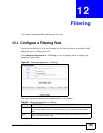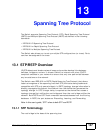
XGS-4526/4528F/4728F User’s Guide
147
CHAPTER 13
Spanning Tree Protocol
The Switch supports Spanning Tree Protocol (STP), Rapid Spanning Tree Protocol
(RSTP) and Multiple Spanning Tree Protocol (MSTP) as defined in the following
standards.
• IEEE 802.1D Spanning Tree Protocol
• IEEE 802.1w Rapid Spanning Tree Protocol
• IEEE 802.1s Multiple Spanning Tree Protocol
The Switch also allows you to set up multiple STP configurations (or trees). Ports
can then be assigned to the trees.
13.1 STP/RSTP Overview
(R)STP detects and breaks network loops and provides backup links between
switches, bridges or routers. It allows a Switch to interact with other (R)STP-
compliant switches in your network to ensure that only one path exists between
any two stations on the network.
The Switch uses IEEE 802.1w RSTP (Rapid Spanning Tree Protocol) that allows
faster convergence of the spanning tree than STP (while also being backwards
compatible with STP-only aware bridges). In RSTP, topology change information is
directly propagated throughout the network from the device that generates the
topology change. In STP, a longer delay is required as the device that causes a
topology change first notifies the root bridge and then the root bridge notifies the
network. Both RSTP and STP flush unwanted learned addresses from the filtering
database. In RSTP, the port states are Discarding, Learning, and Forwarding.
Note: In this user’s guide, “STP” refers to both STP and RSTP.
13.1.1 STP Terminology
The root bridge is the base of the spanning tree.


















